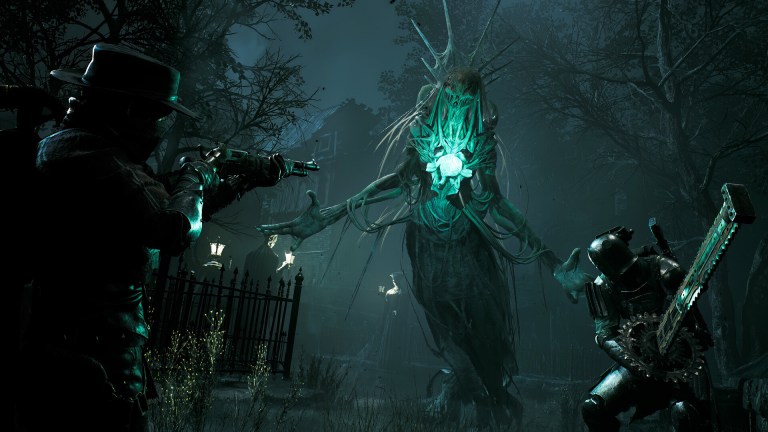Remnant 2 Is The Best Version of The Game Bigger Studios Keep Trying to Make
Despite its surface similarities to other titles, Remnant 2 is the ideal modern action experiences.

A week after its official launch, Remnant 2 has already established itself as one of 2023’s most surprising successes. While Remnant 2’s predecessor (2019’s Remnant: From the Ashes) was critically well-received and a surprise sales success in its own right, Remnant 2 is on another level. In its debut week, Remnant 2 climbed to the top of Steam’s revenue charts. Shortly thereafter, it achieved a peak concurrent player count of over 96,000 players; nearly double the mark its predecessor set and a figure that only the biggest and most popular games typically hope to reach.
If Remnant 2’s incredible word-of-mouth buzz hasn’t reached you quite yet, then there are a few basic things you should know about the game. Remnant 2 is a third-person action title with Soulslike/Roguelike elements. Though much of the game is actually procedurally generated (thus ensuring maximum replayability), Remnant 2 does feature a main narrative that will take you about 20 hours to experience. During that time, you’ll grow your character via RPG-like “build” mechanics as well as item slots that can be filled with various types of (typically customizable) gear. When you’re not in combat, you’ll usually be solving puzzles, completing sidequests, and acquiring new items. Though the game encourages you to play with friends via its co-op mode, Remnant 2 is designed to offer a substantial solo experience.
If you zoned out sometime during that description, I can’t blame you. By changing a couple of words around in the paragraph above, I could have easily described quite a few recent Triple-A titles. A third-person action title with RPG and/or Soulslike elements that offers a variety of optional activities? That’s become the Triple-A bread and butter formula in recent years. Even a quick look at Remnant 2’s gameplay will reveal the floating damage numbers, basic presentation style, and menus you’d typically expect to see in a lot of major releases that emphasize similar features.
Do you know what separates Remnant 2 from its theoretically similar competition, though? Rather than throw a kitchen sink of concepts at you in order to foster the illusion of a more substantial experience, developer Gunfire Games decided to not take any individual elements of Remnant 2 for granted. In doing so, they’ve kind of exposed just how lazy so many modern gaming blockbusters have become.
It starts with the combat. I don’t know who came up with the phrase “Gears of Souls,” but it describes Remnant 2’s core combat quite well. It is as relentless and intense as a Gears of War game, but it actually challenges you to master deeper mechanics you simply won’t find in recent action games like Destiny 2, Gotham Knights, or Borderlands. Learning to dodge, properly position yourself, and exploit enemy patterns/weaknesses is the only way to survive. That combination of concepts culminates in the game’s jaw-dropping boss battles, which are properly epic, multi-stage encounters rather than the skirmishes against larger bullet sponges so many modern titles seem content with.
Remnant 2’s RPG elements greatly contribute to the success of the game’s action. At a time when so many games haphazardly incorporate concepts like skill points and skill trees to foster the illusion of depth, Remnant 2’s character-building mechanics feel worthy of the genre that inspired them. Every class, gear, and skill choice matters in this game, and each of those choices can gradually contribute to substantially different gameplay experiences.
Remnant 2 makes all of its various classes, sub-classes, and even multi-classes feel relatively viable, yet it still allows you to make a suboptimal version of your chosen playstyle. That may sound like a knock, but it is not. It’s a testament to the ways the game encourages you to find the basic playstyle you most enjoy and then use that enthusiasm as the fuel needed to navigate a series of possible optimizations that allow you to constantly experience a genuine sense of progression.
Yet, it’s Remnant 2’s RPG-like quests that surprised me most. Though we’ve seen many games (especially open or large-world games) in recent years that offer an array of sidequests, they typically boil down to simple kill and fetch quests. While some of those do exist in Remnant 2, a surprising number of the game’s quests see you do things like solve murders, uncover conspiracies, and generally participate in the kind of content we typically associate with BioWare-like RPGs.
Even Remnant 2’s puzzles feel like actual puzzles. While some may be frustrated by not being able to clear a logic hurdle in an action game, the fact that the developers bothered to craft thought-provoking puzzles ensures that element of the game matches the intensity, cleverness, and challenges of the rest of the experience rather than just serving as an afterthought that ultimately becomes a burdensome obligation for all involved.
Similar praise could be heaped upon Remnant 2’s various unlockables. I recently celebrated the Resident Evil 4 remake (minus its microtransactions) for featuring an unlock system that rewarded you for playing, uncovering, and enjoying the actual game. Well, Remnant 2 features an even better version of that classic gaming concept. The amount of secret classes, traits, gear, and quests you can unlock in Remnant 2 simply by trying to experience as much of it as possible is stunning. The team even added a secret class to the game they knew players would likely only discover through datamining. Is that excessive? Absolutely, but it speaks to their determination to ensure Remnant 2 feels like a game that is constantly hiding some new and worthwhile discovery.
Even Remnant 2’s co-op system feels like a labor of love rather than another feature to toss onto the back of the box to justify a higher price tag. Many games are undoubtedly enhanced via any kind of co-op system. It turns out that playing games with your friends is fun. Yet, Remnant 2 is balanced in a way that ensures those who play the co-op mode will also get to enjoy a new series of challenges and opportunities that are only made possible through the presence of a partner. Remnant 2 is at its best in co-op, but this isn’t a game like Gotham Knights or Marvel’s Avengers where the only way to get any real enjoyment out of it is to play it with someone else.
Granted, Remnant 2 is far from a perfect game. It lacks that final layer of technical polish we typically see in bigger-budget games, some of its challenges are more frustrating than enjoyable, it could benefit from a smoother progression ramp, and I don’t think the game quite nails its mix of randomized elements and storytelling. This is an improvement over the first game in so many ways, but Gunfire Games is clearly still pursuing the ideal version of this experience.
Yet, I keep coming back to the idea that Remnant 2 feels like the game so many other (and bigger) studios keep trying to make. It features an addictive gameplay loop that is still big enough to make you feel like you’re doing more than just running laps. Its puzzles feel like puzzles, its quests feel like quests, its unlocks are tied to gameplay rather than microtransactions, and it balances role-playing mechanics with all of its action in ways that even the mighty Final Fantasy 16 recently struggled to do. Perhaps most importantly, Remnant 2 offers a genuinely worthwhile co-op option at a time when that mode of play is either not an option or the only way to enjoy fundamentally lacking experiences.
So many modern games try to offer so many things to so many different types of gamers. While I would love to see more modern titles that instead aim to excel at a few key qualities and ideas, Remnant 2 shows that it is indeed possible to combine such gameplay experiences when you give all the aspects of such games the individual love that they deserve.
